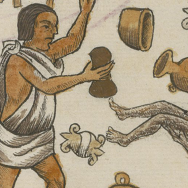Editor’s note: This is part of a Summer Reading Series featuring notable books, author Q&As and more.
In an epidemic, we often focus on three staple metrics: Who does or doesn’t have the disease, the rate at which people are contracting the disease, and the mortality rates. What’s often left out, as explored in a new book by Jenny Trinitapoli, a professor in the Department of Sociology, is the role of uncertainty in the way individuals make decisions. The book, "An Epidemic of Uncertainty: Navigating HIV and Young Adulthood in Malawi," recently was published.
Trinitapoli, a sociologist and demographer, has focused on the social consequences of population dynamics, changing fertility, mortality, and migration patterns and rates, while also exploring the sociology of religion. As a graduate student at the University of Texas at Austin, she began collecting data in Malawi in 2004, and her experience culminated in a project looking at religious responses to HIV in Sub-Saharan Africa.
"An Epidemic of Uncertainty" is based on research that began in 2009 and ran through 2019. Trinitapoli and her team started following a large cohort of 15-to-25-year-olds in Balaka, Malawi for what was designed to be a three-year study to explore the complicated stretch of young adulthood among a group that never knew the world without HIV.
“When this cohort was born, HIV was prevalent and AIDS-related mortality was extremely high; their parents were subjected to the worst mortality rates that Malawi ever experienced, and they have the highest levels of orphanhood of any cohort,” Trinitapoli says. “These levels of HIV constituted their “normal.” We wanted to learn how young people who had experienced the world this way would be making decisions about dating, navigating sexual relationships, getting married, and having children—we were focusing on HIV and fertility in particular.”
The team interviewed this cohort every four months, asking after their relationships, fertility desires, how these things were changing, and how they perceive the risks around them — which included not just HIV, but also malaria, food insecurity, relationship stability, and finding work.
But as the study wrapped, the team noticed how new policies, especially the lifesaving antiretroviral therapies that became available during the course of their research and a series of changes to family law, were changing the context in profound ways. Two more iterations of the study followed, and Trinitapoli wound up with a decade of observations from this cohort.
When Trinitapoli began outlining a book project in 2015, she was motivated to argue both for a particular research approach and against some erroneous but widely circulating ideas about HIV in Africa. For one, she was arguing for the importance of studying uncertainty and of population-based research for understanding epidemics broadly.
“That might sound like an obvious thing,” Trinitapoli says. “But the vast majority of the knowledge base for HIV and many other health conditions comes from clinical studies, from selective samples, from people who are sick or who likely already have the condition. I’m arguing that the longitudinal, population-level view is essential for understanding the arc of HIV in this community and disease patterns broadly. The data we collect from clinical samples enrolled in HIV care is important, but it’s insufficient for understanding the epidemic. The scientific community hasn’t always prioritized population-level data, but we can’t understand the world without it.”
What became clear from her research was that most young adults wanted to have children; “unprotected sex” is considered a risky behavior when it comes to HIV transmission, but it is also essential for childbearing. The dilemma of avoiding HIV while conceiving and bearing wanted children offered an opportunity to study the role of known-unknowns in daily life.
“High levels of uncertainty or ambiguity about one's HIV status is actually a characteristic of the epidemic; it’s not a problem of ignorance,” she says. “One stereotype that circulates widely is that Malawians don't want to know their HIV status, or that they won't get tested because they don't want to face reality. That’s completely wrong.”
Trinitapoli underscores two particular surprises from the research, as it relates to uncertainty. First, after randomizing when participants would be tested, the team expected that those who received their results would feel more certain about their HIV status than if they didn't get a test result. But there was no proof that those tested felt significantly more certain about their status than others.
“We expected that getting biomarker results in a clinical setting would give people certainty,“ Trinitapoli says. “But that wasn’t the case in our sample, and it won’t be the case when the risks a population lives with are ongoing and omnipresent. Imagine the process for detecting COVID or lead levels in small children. The results are useful but always qualified. COVID test results that you might get on a Tuesday morning may or may not give you the assurance that you need to go visit an aging parent on Wednesday.”
The second surprise, she says, was how stable uncertainty was in the population. While Malawi experiences a particularly severe HIV epidemic, most people don't have HIV. At epidemic levels of around 10% prevalence, about 40% of respondents, at any given time, said that they didn't know their HIV status.
“Our estimate of HIV uncertainty was the same in 2009, 2012, 2015, and 2019. But it wasn’t always the same 40%; respondents moved in and out of the state of uncertainty over time based on recent test results, conversations they overheard at a funeral, changes they perceived in their own health, the conclusion of a risky sexual relationship, or the suspicions they felt about their partners. The stability of HIV uncertainty over time in this population suggests that it’s capturing something bigger than just the summed experiences of individuals.”
Overall, Trinitapoli’s book emphasizes how biomarker data is, in many cases, both essential and partial.
“Biomarker results are pieces of information that we integrate alongside many other pieces, especially our perceptions about the world we live in,” she says. “Uncertainty becomes a part of our daily life; it’s dynamic, more and less intense on different days and over distinct periods of time. But it really does motivate our actions.”
“An Epidemic of Uncertainty” is available from UChicago Press.
This story originally appeared on the Division of the Social Sciences website.

